Here in Texas, we don’t really enjoy traditional autumn colors from our trees and shrubs as is common in New England, the Midwest, or even the Pacific Northwest. The dramatic foliage mosaic that defines “fall” for many doesn’t occur for us in October. Our deciduous trees transform their leaf color in response to less light and colder temperatures, but that conversion isn’t until late November/December and transpires over a longer stretch of time, versus the spectacular two or three-week performance in October typical to other parts of the United States. However, we in Texas are gifted a second blooming period in the fall months (until the first hard freeze), which rivals our spring beauty. Accompanying that second bloom extravaganza, there are many trees and shrubs which berry, providing food for indigenous and migrating birds. My favorite of the berrying shrubs is the American Beautyberry or French Mulberry, Callicarpa americana. Continuing with the series, A Seasonal Look, I would like to share my experiences with this wonderful native shrub.
American Beautyberry is a native deciduous shrub throughout the American South, including Texas. It is usually a medium-sized shrub, but can grow quite large in cultivated gardens. My original plant,
grew to about six feet tall and about ten feet across before it began a decline which continues, although the plant is still living. This specimen,
…planted in the Howson Library garden in Austin, isn’t as large as mine, but it is substantial. Beautyberry develops arching branches and is best left in its natural form; it’s not a plant you want to prune for “neatness.” In this natural form, it provides cover for wildlife and that’s always a good thing. Gardeners can prune the dormant shrub to about a foot from the ground in late winter if a more compact size is the goal. I’ve never pruned my Beautyberries, except for stem waywardness (that’s a quirky definition) and when stems died, as has happened with my original shrub.
Known primarily for the showy, purple berries or fruits which form in clusters along the branches,
…the American Beautyberry is drought tolerant, a good wildlife plant, and a lovely landscape shrub for the Southern garden. In late September, October, and November. it reaches the zenith of its beauty. Those berries!
They are quite something in the garden. I’ve always thought they look otherworldly, not entirely natural.
That’s a natural color?
Yes, the color is of this world and the birds love the berries! Usually in my garden, it’s the Mockingbirds who stake their claim to ownership of the berries, one or two Mocks fighting off other birds for the privilege of fine bird dining that the sumptuous berries provide. But I’ve also seen Blue Jays as well, swooping onto the shrub, then hopping from branch to branch, plucking and munching as they go. The berries are an unusual, bright, almost metallic, purple, and if the birds don’t eat them up within a few weeks, gardeners can enjoy their gorgeousness for quite a long time. I’ve read that the fruits can be made into jelly, but I haven’t tried that, nor have I ever tasted either the berries or jelly. There are also white-fruited Beautyberries–White American Beautyberry, Callicarpa americana var. lactea. At Zilker Botanical Garden, several grow in the Green Garden and I’ve seen White Beautyberries for sale at nurseries. I like them and more importantly, the birds like them, but the purple has my heart.
Additionally, deer favor the leaves, so Beautyberry is not a good plant if you share your garden space with those particular mammals. I said it was a good wildlife plant, didn’t I?
After the inevitable freeze, the berries (if birds have left any) shrivel up. Also, after the first hard freeze, the foliage of the Beautyberry will turn yellow and drop. The Beautyberry remains bare of leaves and (usually) of berries for the duration of winter.
This specimen is my original plant. It’s about eighteen years old and began declining about a year ago. The branches died, one by one, and I’ve prune most of them off. Assuming that the original was on its way out, I planted a new Beautyberry in October 2013,
….next to the original. The new Beautyberry has the tall stem which towers over the the original, which is significantly shorter and with fewer branches. The original shrub produced berries this year,
…but the new Beautyberry didn’t, though it bloomed in early summer. Along with this new specimen in my front garden, I planted another in the back garden.
…which sports fruit clusters this fall (2014). The back garden Beautyberry receives no direct sun, only dappled light,
…and the Beautyberry in the front receives dappled light most of the day, then is blasted by the last of the west sun. The soil in which it resides dries out during the summer. I hand-watered when the Beautyberry looked pathetic and it’s weathered its first summer well.
The back Beautyberry is situated in generally moist soil, because of shade and the clay content of the soil. I think that explains the difference in fruit production for this year, though I expect both shrubs will produce berries equally as the plants mature and the roots establish themselves. According the the Lady Bird Johnson Wildflower Center’s page on American Beautyberry, this shrub prefers a moist, bottomland type of soil, but I’ve seen them planted in a variety of situations. Beautyberries thrive in either sun or shade and varying soil types, but are drought tolerant in shade or part shade, requiring more irrigation with more sun exposure. Beautyberry is adaptable. My father grows a huge one in Corpus Christi, in full sun, in sand. He irrigates more than I do.
Once spring temperatures warm and the days lengthen, fresh, new leaves emerge. Tiny at first,
…they grow rapidly to their full size.
These photos show the newly planted Beautyberries from last spring, but established Beautyberry shrubs leaf out similarly. The leaves grow large, are thin rather than thick, and are light, bright green in color. They form opposite from one another and are slightly serrated. The leaves reportedly contain a chemical which repels insects from people and livestock. I haven’t tested that by crushing a leaf and spreading it on my skin, but I should, as there are plenty of mosquitos in the gardens.
In May, the Beautyberry begins blossoming for about six weeks with delicate pink flowers.
Flowering occurs at the nodes of the leaves,
…and as the flowers fade, the green fruits develop. The green berries remain on the main stem throughout summer.
The berries begin their gradual transformation to the iconic purple sometime in August,
along the stems of the shrubs, cluster by cluster.
And then–Shazamm!
Those are some purple berries!
I confess that I get annoyed in those years when the birds snarf the berries within a week or two of the Great Purpling. I wish they’d leave them, just a little longer, for me to enjoy. But while I may long for and appreciate the beauty of the berries, the birds need the berries for sustenance. I plant this beautiful native shrub for the birds–I can’t really complain when they do what I want them to do–eat the berries, fill their tummies, and spread Beautyberry joy throughout the land–or at least, throughout the neighborhood.
So goes a year in the life of an American Beautyberry. It’s a desirable understory shrub–valuable for its landscape qualities and its importance for wildlife. Plant one today!
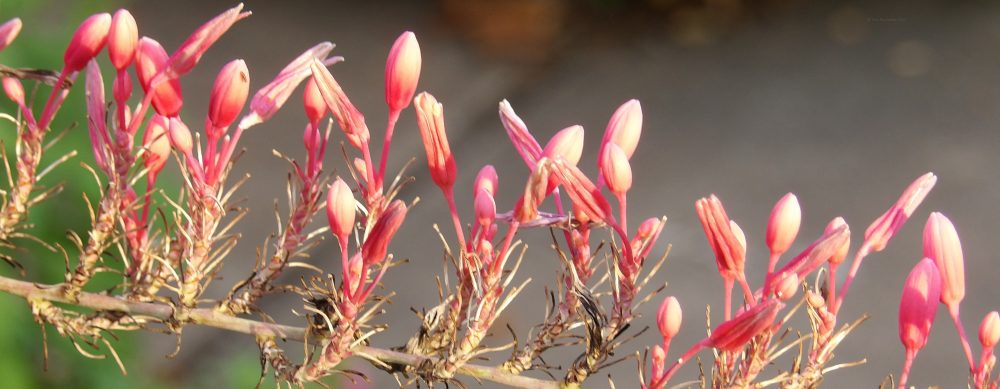
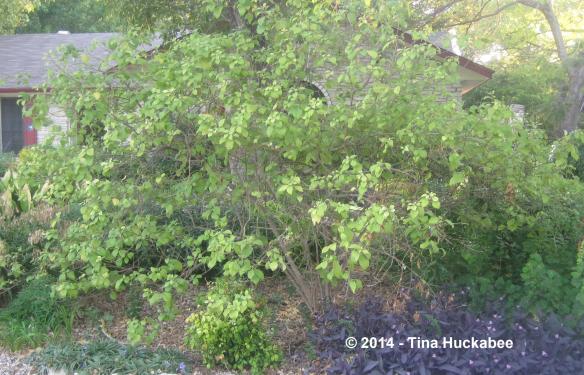
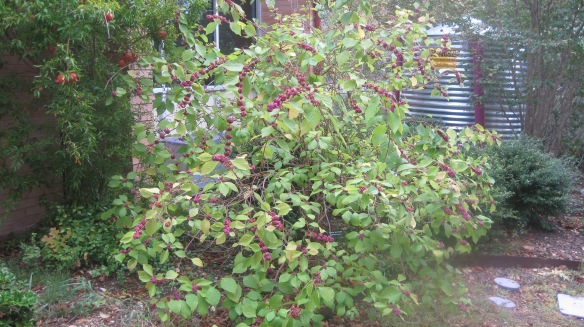
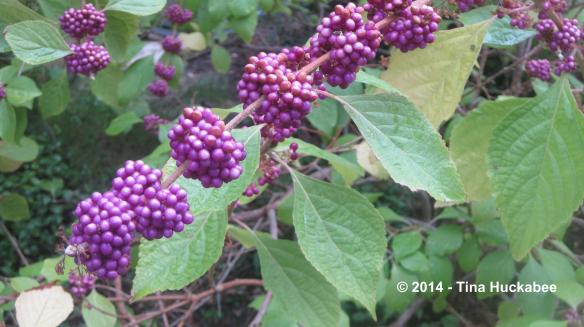
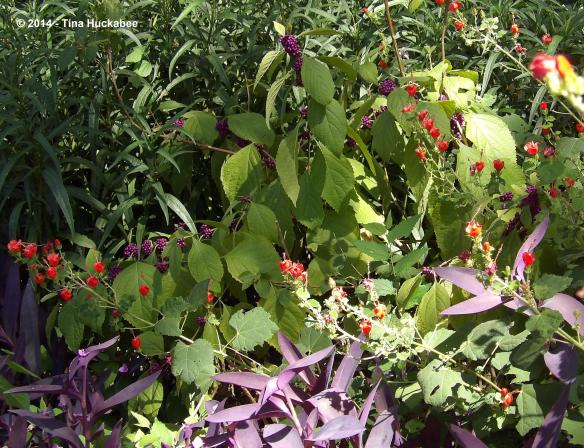
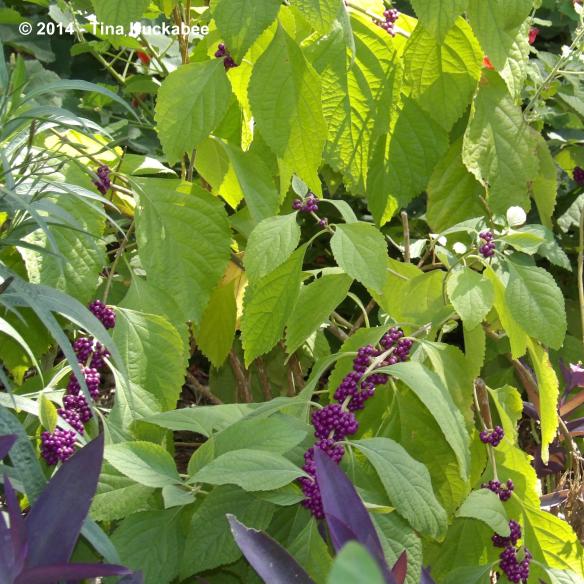
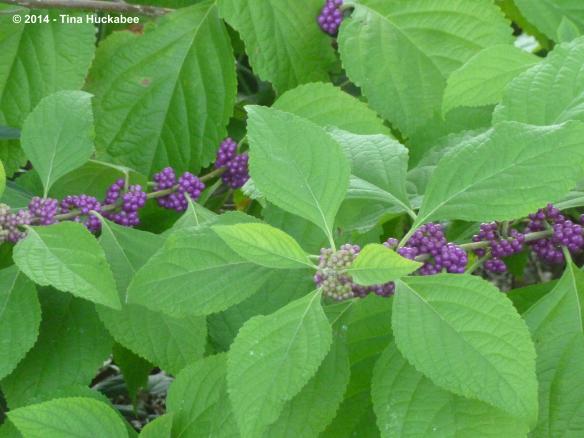
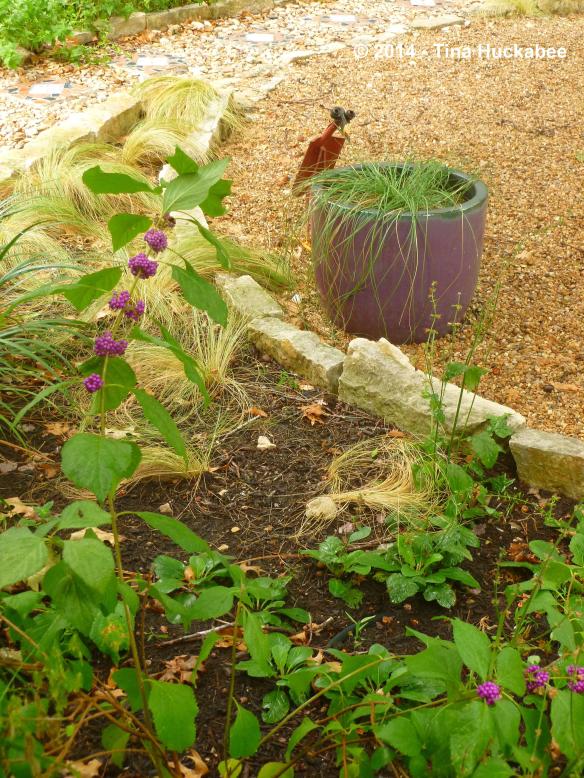
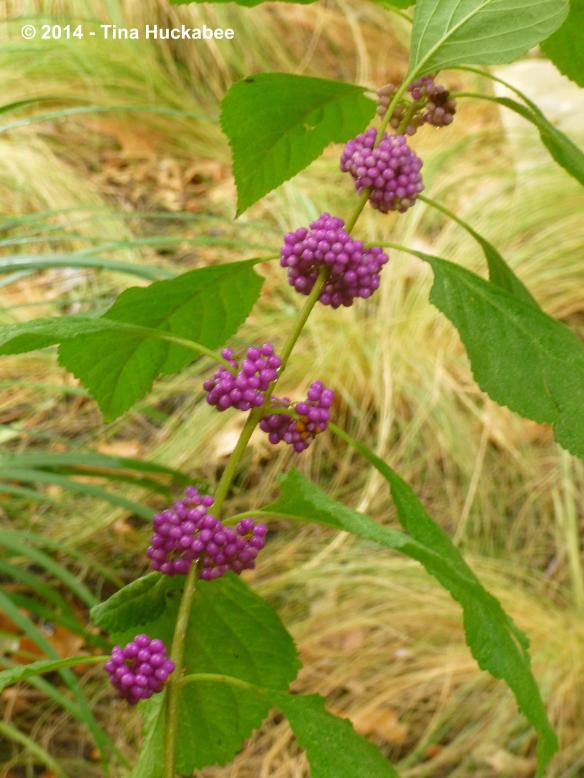
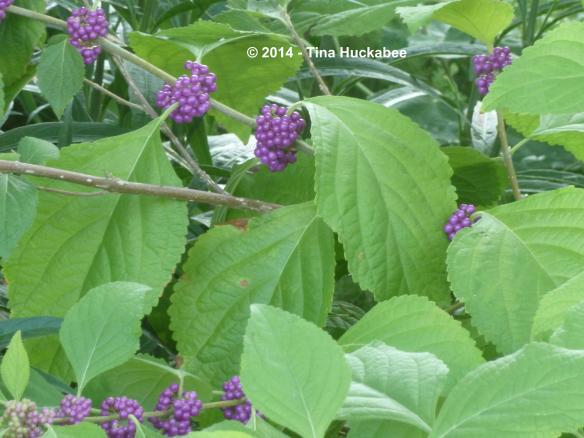
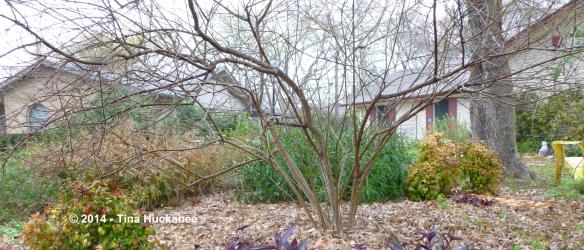
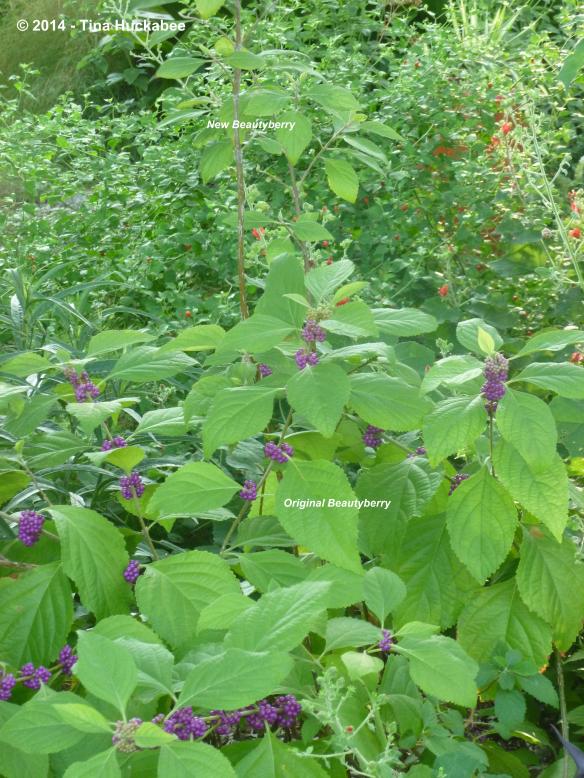
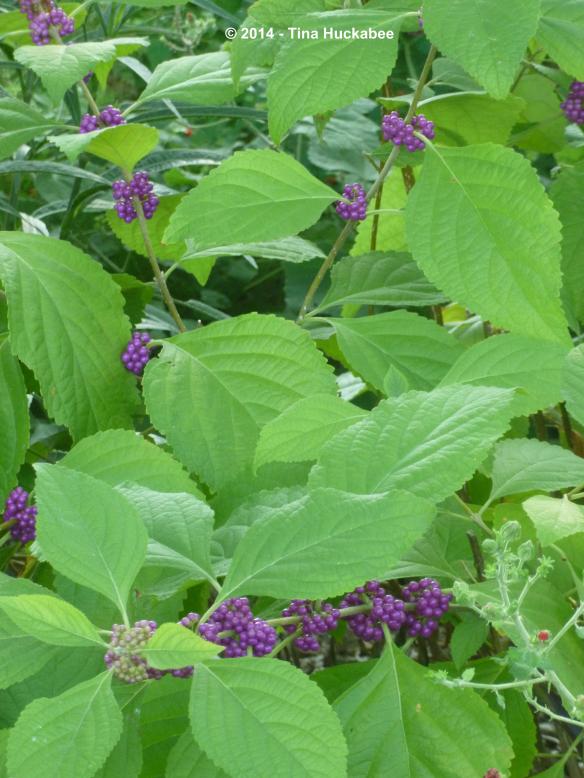
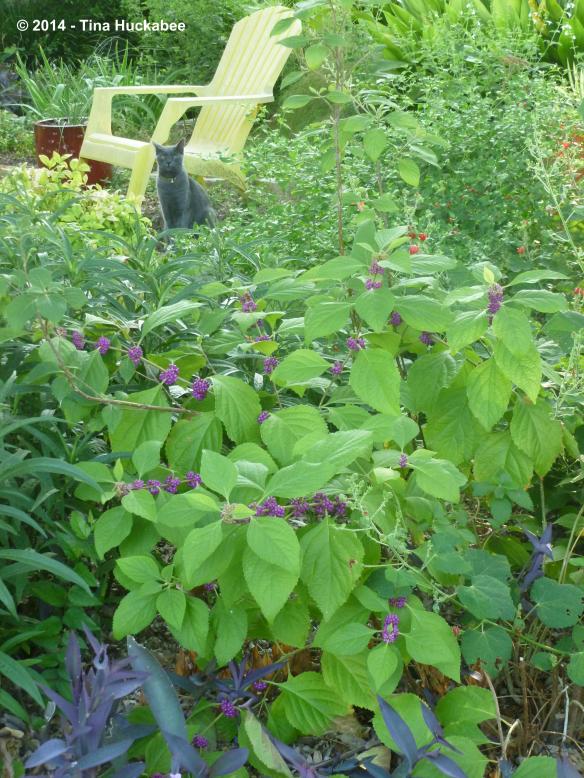
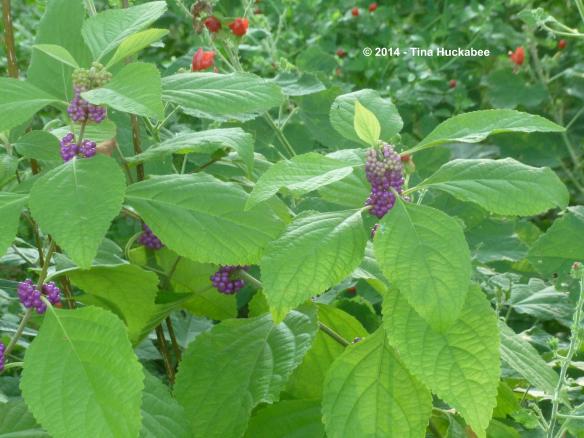
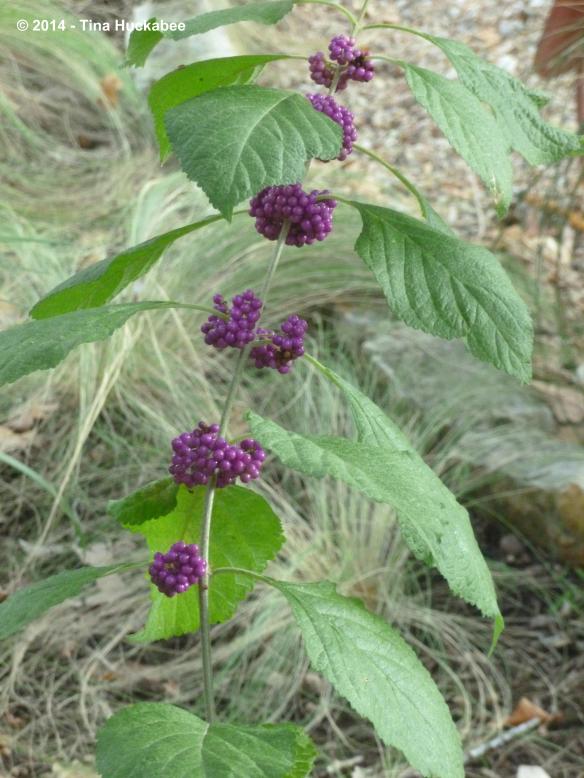
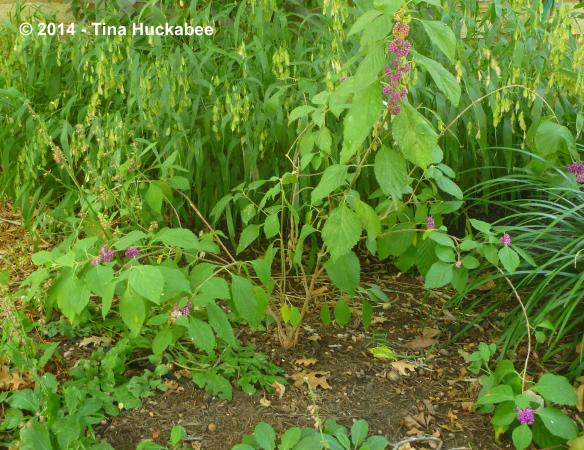
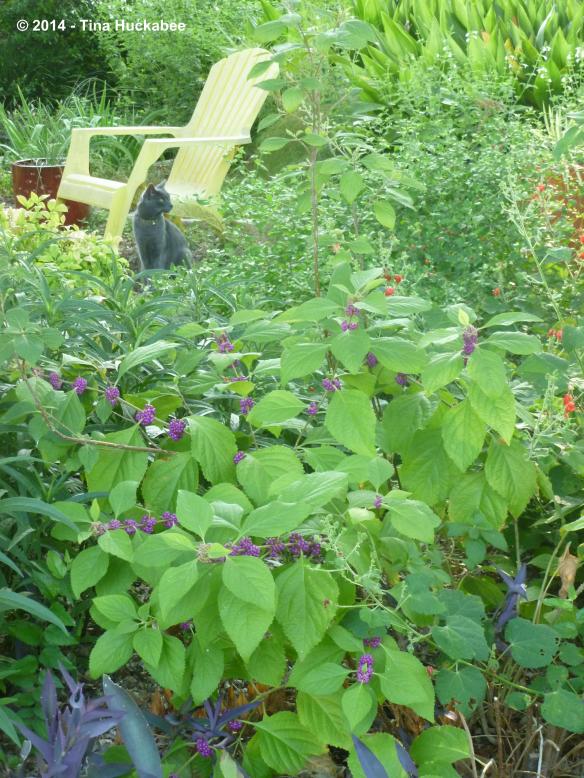
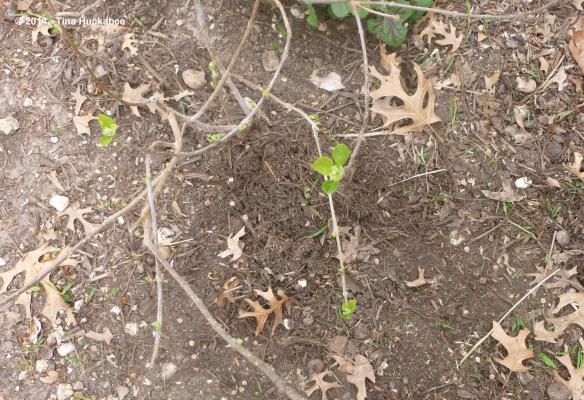
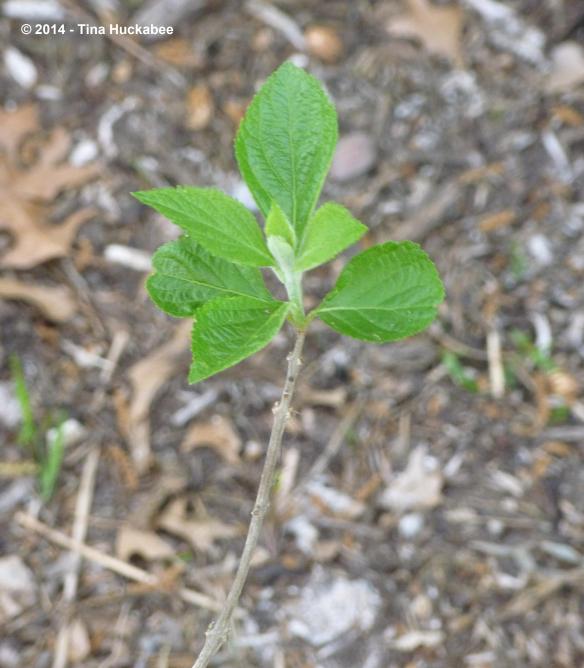
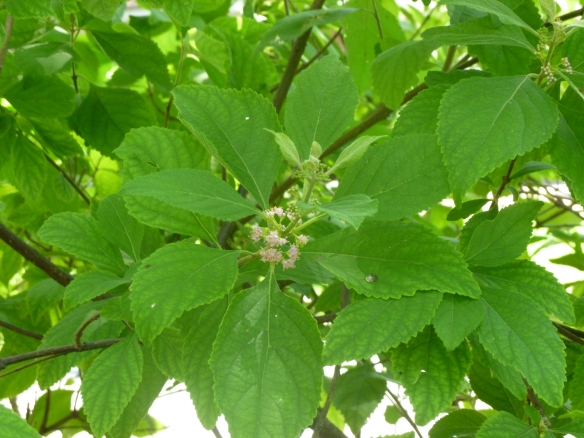
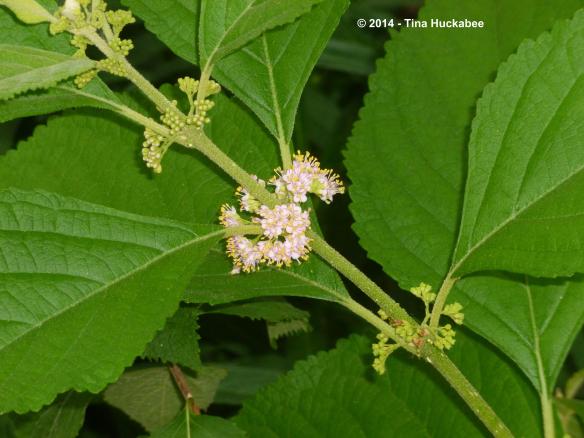
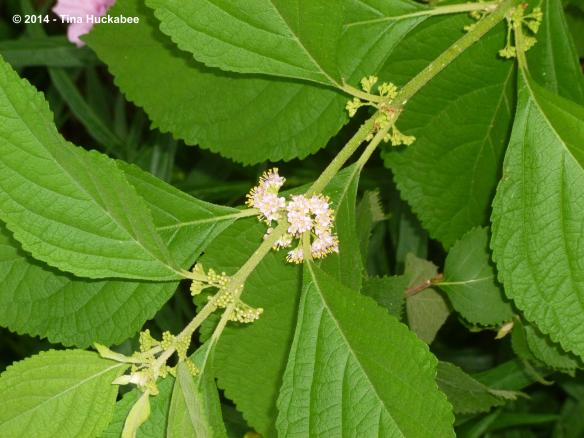
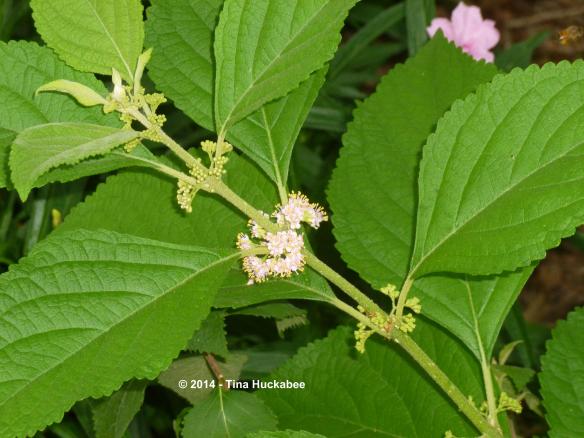
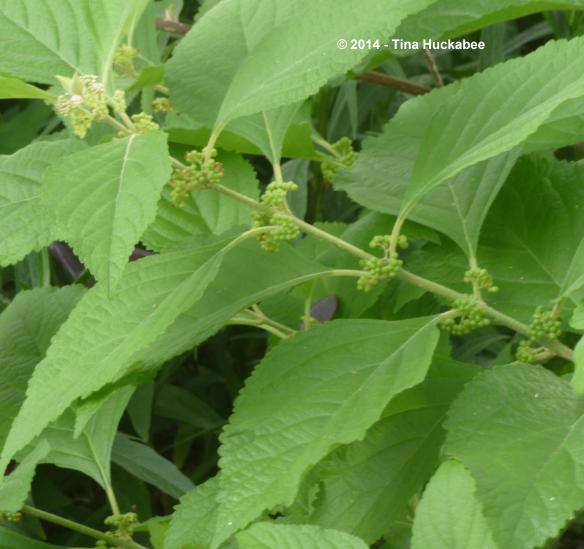
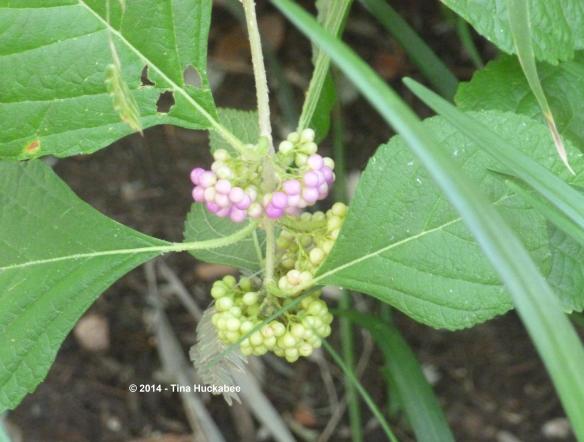
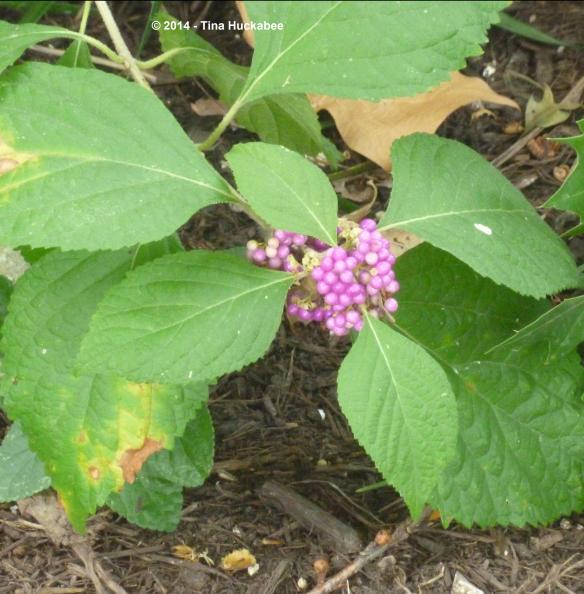
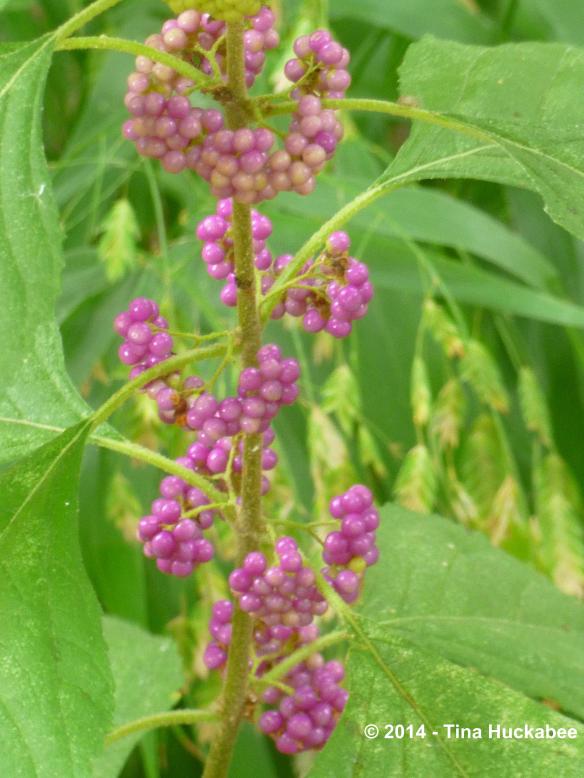
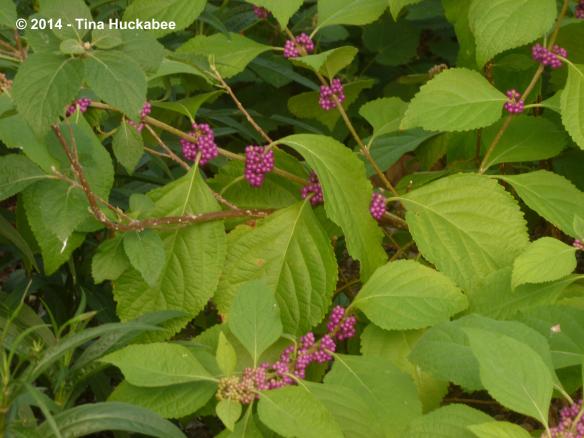
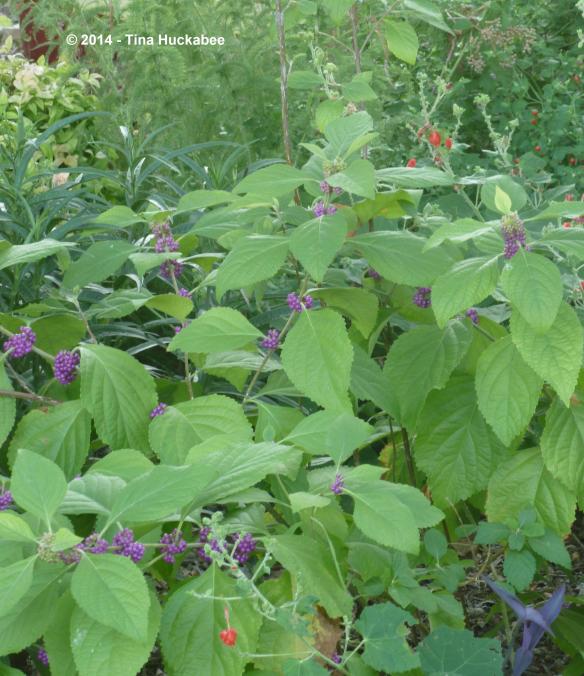

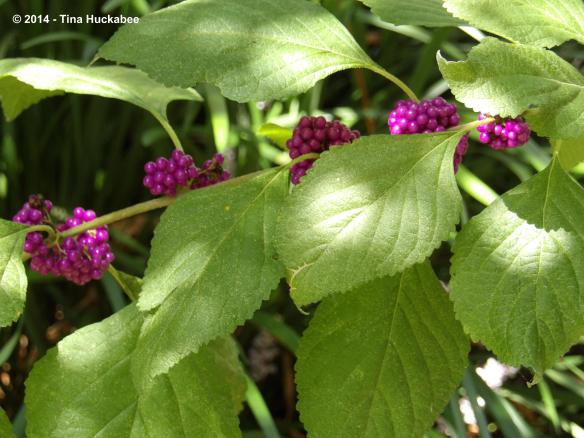
It is beautiful. I can’ t think of any other shrub that has purple berries. I did grow this once but it died. I think I shall have to try again. It is gorgeous.
LikeLike
I would imagine you’re just a little too cold in Suffolk for this shrub. But, maybe in a container? It wouldn’t get as large, but I bet you’d still have berries. I agree–it is lovely.
LikeLike
Chloris, if you try it in a container (or anywhere else, for that matter), please post about it–I’d be really interested in how it does for you.
LikeLike
You are so singing my song here. I just transplanted a volunteer beauty berry two days ago and I’m carefully hand watering to pamper it along as it gets re-established. As a young family when The Hub and our kids first moved back to East Texas there were beauty berry bushes growing everywhere under the tall pines. I’d never seen them before and was absolutely gobsmacked by those purple berries. Since then I’ve had one or more everywhere we’ve lived. Beauty berry bushes seem to be having their moment and that is a very good thing. The more of these are planted in our area the longer the berries will last? Maybe… : )
(The deer do browse the young leaves but seem never to kill the plants outright. Perhaps the more mature leaves don’t taste as good? )
LikeLike
You know, I don’t remember ever seeing them as I grew up in Texas, but I probably just didn’t notice. Gobsmacked is a good description of how those shrubs would render the first-time viewer. The color of the berries is just…so odd. Now is definitely their time to shine–those berries all dramatic and such. 🙂 The shrub itself is a little bland, though I like its shape very much. I don’t ever get volunteers–not sure why, though I hope there are some growing elsewhere in the world because of those I’ve planted (oh, and the birds helping to re-distribute!).
LikeLike
I recently saw a mass planting of them and I thought that look really worked — a kind of deciduous hedge row instead of the more typical specimen planting. It was at the riparian garden in the Mueller Greenbelt. Amazingly, it seems the birds (and believe me there are ever so many there) have left the berries untouched. I’ve been poking around trying to figure out what they are eating instead. =) These American subtropics really do differ from temperate zones with their four seasons. Having a second spring with flowers everywhere AND fruit at the same time just doesn’t get old. Many birds — like the mockingbird — are preparing to nest again. The surprise heat wave this year is a little less welcome.
LikeLike
I haven’t seen the plantings at Mueller–I’ll need to check that out. I bet that’s very striking–clumps of beauty berries clustered together. I’ve noticed that some years, the birds just don’t eat them much and other years, the berries disappear within a short time. I hope that doesn’t mean there are that many fewer birds. Maybe it means there is more for them to eat. I’m also tired of the heat–I so hoped we were done.
LikeLike
You probably already know the Mueller greenway was designed by the Lady Bird Wildflower peeps. There is so much to see there and it is mostly unknown. Give yourself plenty of time. There are al kinds of secret passages off the main hike & bike trail. Many mornings I am the only person there so it can feel like my own private estate. If you get a chance to visit I do recommend it. The Mueller greenbelt (not the big pond by the Thinkery but the prairie, ponds and gardens to the South) is a birding hotspot so I doubt there is a population decline. I kind of think that there is such a diversity of plantings and wildlife that the mockingbirds are making some other choice — possibly protein rich insects — for the moment.
LikeLike
Wow! Thanks for that information. I haven’t been there, only the park area around the pond. It’s on the to-do list for the next week or so! You’re probably right–about the diversity of available seed/plant choices and the need for protein in their diets. I wish they would eat mosquitos. I have plenty of those!
LikeLike
You presented Beautyberries in such a good light. I am ambivalent about them, so I wrote about mine and linked back to you, mentioning that you said good things about them.
LikeLike
I do like them, but I can understand if you have them volunteer everywhere, they’d be annoying in the garden. As I said with Deb, the shrub itself is not a particularly beautiful shrub, though nicely shaped. But those berries–I just love them!
LikeLike
Pingback: In Late Summer | My Gardener Says…
Pingback: Change | My Gardener Says…
Pingback: Native Season | My Gardener Says…
Great coverage of the beautyberry. I have a mulberry in my front yard, a gift from a friend a few years back. Bit no berries yet!
LikeLike
Thanks! We have mulberries here too, though none anywhere near to where I live.
LikeLiked by 1 person
wow – The 18 year old beauty berry looked amazing. Do you have any pictures of it with berries while it was alive??
I encountered a beautyberry “tree” (~5ft ht in Cambridge Mass) and was always so curious how they did that considering that it is usually a shrub. I assume you just remove all but the leader branch and just kept letting it go until it is big enough?? I tried doing this one time and it made it to year 3 and then was cut down by an inproficient gardener 😦 .
Thanks for the read – I love this plant!
LikeLike
I love this plant too, Michael! Beautyberries can get quite large, though that seems to depend on how much sun they get, or, that seems to be the case here in Central Texas. I’ve seen some gorgeous ones in British Columbian, though I suspected that they were hybrids/cultivars. Still, they were stunning.
LikeLike
It isn’t a tree, just a sprawling bush with graceful out reaching arms. Foilage is not real great, but I admired a mature shrub on a corner and was so taken with the color of those berries that I stopped and ask the owner what it was. She was so kind, she said I think I have a cutting I can give you and I so appreciated the gift as it has grown, and sprawled along an East fence where it gets lots of morning sun and protective shade by being under a Rosy pink Crepe Myrtle. I am astonished at the huge Mockingbird species that will not leave it alone when the berries are ripe. I have a lot of Deer, but have not experienced them chewing on young leaves. I undesrtand this plant has a lot of medicinal uses and rubbing the leaf on ones hat or shirt repels the mosquitos.The color of my berries is a cross of purple and heather and is simply gorgeous. I am sending one to my son and wife in Richland Hills, Texas. Mine survived 9o this past winter, they went to 3o so hope it survives.
LikeLike
An excellent plant for both gardeners and wildlife! Mine also rebounded beautifully from February’s storm.
LikeLike
Pingback: Berry Good! | My Gardener Says…